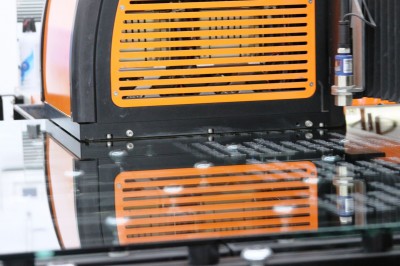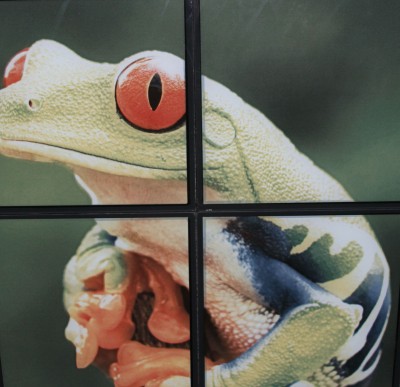Benefits and limitations
The benefits of digital printing over screenprinting on glass can include cost savings, greater design flexibility and easier repeatability. In addition to the ability to produce custom images with many colours, digital printing can incorporate micro-lines, micro-dots and dual images (i.e. two different graphics that can be seen from either side of a single pane of glass, even though they have been printed on the same surface).
Another advantage is the design files for digital printing are stored electronically, with none of the typical storage costs of screens. Graphic replacements and reproductions can be printed years later with dependable results.

Inkjet printers with drop-on-demand technology use a programmable printhead that traverses back and forth just above the glass. Photos courtesy Brian R. Savage
There can still be challenges. From an architectural perspective, calculating a façade’s solar performance can be difficult because, as mentioned, different ink colours will transmit light and heat at different levels, even within a single pane of glass.
Matching the appearance of the actual graphics to the designer’s vision can also be challenging, for the same reasons. The amount of light being transmitted and reflected during a sunny or cloudy day or at nighttime will affect the way images are perceived. Applying a coating over the graphics can also mute the vibrancy of their colours.
For that matter, the choice of glass substrate can cause graphics to appear differently than designed. Regular clear glass often adds a green hue, which a lower-iron glass may help subdue. All of these issues need to be taken into account when designing the graphics in the first place. With electronic design file manipulation for digital printing, it is possible to make adjustments to compensate for such factors as solar performance, light levels and privacy.

If an image will be tiled across multiple panes, adjustments must be made to allow for mullions and any other interruptions.
Vision versatility
The architectural market represents a source of constant demand for designers to leave their mark on buildings at a grand scale. As digital printing has emerged as a versatile, colourful way to define architects’ visions on a building’s façade and on interior walls, it can mean significant opportunities for sign and graphics shops as suppliers to this market.
With ceramic inkjet printing systems, they are equipped with the software and hardware to fine-tune graphics to optimize solar control, privacy and other functional aspects of architecture, as well as achieve esthetic aims. And architects will appreciate the durability of ceramic frit applications, which have already been used in their field for years.
Brian R. Savage is a product manager at Viracon, an architectural glass fabricator. For more information, contact him via e-mail at bsavage@viracon.com.





